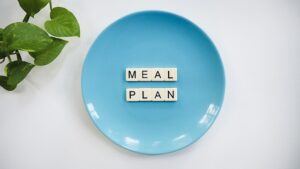Do you want to do intermittent fasting? Great!
But you’re also busy and want to plan and prepare your meals effectively. I’m here to help you with that. Intermittent fasting (IF) isn’t just about choosing when to eat and when not to; it’s also about what you eat during your eating windows to make the most of your nutrition.
Understanding intermittent fasting is the first step. This 101 article is a great place to start if you don’t already know.
The beauty of popular variations like 16:8, where you fast for 16 hours and eat during an 8-hour window, or the 5:2 diet, where you usually eat for five days and restrict calories for two, is their flexibility.
They can be tailored to suit your unique lifestyle, allowing you to design a fasting routine that works for you.
So, how does meal planning fit in?
Picture this: you’re in your eating window, and instead of scrambling to find something to eat, you have a delicious, nutritious meal ready to go. That will include using the right strategies, like batch cooking and learning to balance macronutrients and micronutrients efficiently.
In my opinion, if you want to succeed with intermittent fasting, prioritizing meal prep is non-negotiable. But don’t worry too much about mastering everything overnight.
Remember, this is a journey, and you can constantly adjust your approach as you learn and grow in your understanding of intermittent fasting.
Choose a plan that resonates with you. A strategy you can stick with is always better than a perfect one you can’t.
Selecting a plan that aligns with your preferences and lifestyle will make you feel more connected and committed to your intermittent fasting journey.
After covering the basics, you’ll learn how to incorporate your meal prep into the grander scheme of your daily life. That will include seizing control of the clock and nailing down meal timing to ensure your intermittent fasting journey is as smooth and beneficial as possible.
Conquering the Clock: Timing Your Meals Right

Knowing how to sync your meal prep with your intermittent fasting plan is essential. After all, timing is everything. Tailoring your cooking and eating schedule is how to maximize the benefits of the fasting periods.
This isn’t just about what you eat; it’s also about when you eat.
If you want to align your meal timings with typical intermittent fasting schedules like 16:8 or 5:2, you are timing around a specific eating window. This ‘eating window’ is the period during the day when you consume your meals, and it’s crucial to plan your meals to fit within this window.
Let’s say you’re following the 16:8 method, eating from noon to 8 PM and fasting for the remaining 16 hours. Here’s the strategy I like to leverage: prep your meals in the morning or the night before. This way, you’re not scrambling to cook when you should be eating.
If you want to align your meal timings with other types of intermittent fasting schedules, like Alternate-Day Fasting or OMAD, you are timing around specific eating periods that may change day by day.
Let’s say you’re following OMAD, fasting all day, and only eating once a day. If you prep your meal in the morning or the night before, you could have an opportunity to prep a large portion of the same meal since you only eat once during the day, and the large portion would go a long way.
Don’t worry too much about staying hungry.
Consider meal prepping to match your circadian rhythms, which are your body’s natural internal processes that regulate your sleep-wake cycle and other physiological functions.
Consuming larger meals earlier in the day can be beneficial when metabolism is generally higher. Plus, more minor, nutrient-rich meals can tide you over if you are an evening eater.
An intelligent approach is to ease into intermittent fasting using meal prep. Start with simple, easy-to-digest meals during the eating window. These could be a balanced salad with protein, a vegetable stir-fry with quinoa, or a hearty soup.
This helps your body adjust and may prevent the initial hunger pangs you might experience in the early days.
Then, when you are ready, you can start adding to meal plans and carefully adjusting what you want to eat after getting used to intermittent fasting.
Efficient Meal Prep Strategies for the Busy Individual

Including efficient meal prep strategies can make achieving success with intermittent fasting doable even when life is busy. They’re a dream come true for anyone juggling work, family, and self-care while trying to stick to an intermittent fasting plan.
Batch cooking
This method involves preparing large quantities of food simultaneously to save time during the week.
- Prepare large quantities of food immediately, then portion them out for the week. This is especially useful for soups, stews, casseroles, and pasta dishes.
- Freeze meals that won’t be eaten within a few days to maintain freshness.
Time management
It is critical, especially when you’ve got a to-do list as long as your arm.
- Dedicate time each week to plan your meals. Decide what you’ll eat for breakfast, lunch, dinner, and snacks.
- Choose specific days and times each week to prepare your meals.
- Consider recipes that use similar ingredients to save money and reduce waste.
Tools & Equipment
Having the right tools and equipment can make a world of difference.
- Invest in quality containers for portioning and storing meals.
- Glass containers are durable and can be used for both storage and reheating.
- Portion-sized containers make it easy to grab and go.
- Slow or pressure cookers are great for hands-off cooking.
- A good-quality blender is good for quick smoothies or soups.
Multi-purpose Ingredients
Choose ingredients that can be used in multiple meals.
- Roasted vegetables can be added to salads, wraps, or as a side dish.
- Make sauces or dressings that can be used in different dishes for variety.
- Batch-cooking staples like grains, proteins, and roasted vegetables can create versatile meals throughout the week.
Stay Organized
It can be hard to keep organized when you feel busy, but it is the way to avoid burning out or overwhelming yourself.
- Keep your pantry and fridge organized to find what you need quickly.
- Rotate older items to the front to be used before expiring.
- Label your containers with the contents and date. This will help you track what to eat first and prevent food from going to waste.
- Use freezer-friendly labels if you’re storing meals for more extended periods.
This isn’t just about saving hours; it’s also about creating a meal prep routine that becomes second nature.
Consistency is key.
Choose something that resonates with your schedule and stick with it if you have unexpected free time. Prep components like washed and chopped veggies, cooked grains, or marinated proteins that can be quickly assembled into meals later.
What’s great is that having meals ready allows you to adjust your approach continuously.
If a busy day pops up, you’re covered with a healthy meal that fits right into your intermittent fasting schedule—no stress or extra time needed.

Remember, it’s not just about when you eat; it’s also about what you eat. With a limited eating window, each meal has to pack a punch in terms of nutrition.
Protein
Protein is your friend, but not just any protein. You want to choose sources that are both lean and varied. Think chicken breast, fish, legumes, and tofu. These will fuel your muscles and keep you feeling fuller and longer.
Fats
Please don’t shy away from fats, but be smart about them. Opt for heart-healthy options like avocados, nuts, and seeds. They’re not just good for your ticker; they’ll also keep your energy levels up.
Carbs
Carbohydrates can be tricky, but they’re an essential energy source. I advise going for complex carbs, like whole grains and vegetables. They’ll give you that steady energy release, helping you power through your day and your fasting periods.
Vitamins and Minerals
It’s not all about macros, though. You can’t forget your vitamins and minerals – these little guys play a big part in a well-functioning body. Leafy greens, berries, and nuts will be your go-to for these nutrients.
With intermittent fasting, knowing the essential things you should be eating and drinking is important so that you achieve as many benefits from fasting as possible. Check out this article if you aren’t sure what to eat. Check out this one if you aren’t sure what to drink.
Overcoming Challenges and Staying Motivated

I know that sticking to intermittent fasting and maintaining a solid meal prep routine can sometimes be daunting.
Everyone faces obstacles now and then, whether it’s a curveball in your schedule or a dip in your motivation. But don’t worry too much about it—you’re not alone, and there are strategies to get back on track.
1. Always Keep Things Interesting
First, let’s discuss how keeping your meals interesting can help you maintain your fasting regimen. You don’t want meal prep to feel like a chore. So, choosing something that resonates with you taste-wise is crucial.
I’m always experimenting when I’m meal-prepping. Experiment with spices, try new recipes and allow your meal prep to be a space for culinary creativity. This isn’t just about nutrition; it’s also about enjoyment!
2. Remember Your Why
If you ever feel your motivation waning, remember why you started intermittent fasting in the first place. Aligning with your ‘why’ can be a powerful motivator.
And if you’re feeling stuck, mindfulness practices can remind you to stay present and focused on your goals. Reflect on how far you’ve come and the benefits you’ve already experienced. That sense of accomplishment? It’s a fantastic motivator.
Learn more about mindfulness strategies here.
3. Have Support
Community support can be a game-changer. Whether it’s online forums, social media groups, or friends and family who also practice intermittent fasting—connecting with others provides encouragement and shared experiences. Swap meal prep tips, celebrate successes, and keep each other accountable.
I hope you’ve found these insights helpful and that they have equipped you with the tools you need to tackle intermittent fasting meal prep with confidence.
Remember, your first attempt doesn’t need to be your last.
Keep refining your approach, stay flexible, and watch as your efforts yield results.
Happy Fasting!
